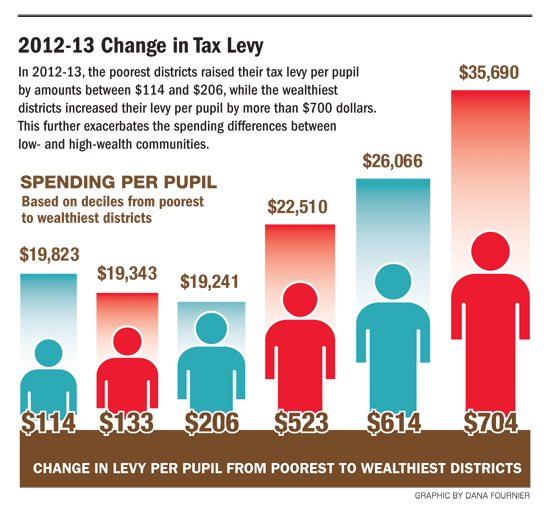The fact that New York's tax cap law requires a 60 percent supermajority to approve many school district budgets is bad enough.
Even worse, according to recent NYSUT analysis, is the way the tax cap exacerbates the gap between the haves and the have-nots.
"The way New York funds public education is already grossly inequitable, denying the poorest students with the greatest needs the rich array of programs and services they need for success - services more affluent students get every single day," said NYSUT President Dick Iannuzzi.
The wealthiest 10 percent of school districts in New York spend 80 percent more educating students than the poorest 10 percent - a funding inequity that is aggravated by the state's property tax cap and widening the unacceptable achievement gap.
"The tax cap takes this grotesque educational inequality and amplifies it," Iannuzzi said.

NYSUT's analysis, submitted as part of the union's lawsuit seeking to have the tax cap declared unconstitutional, also compares student achievement and per-pupil spending. In the highest spending 10 percent of districts, 49 percent of students reached proficiency targets on last April's English Language Arts test, while 45 percent were labeled proficient in math.
Among the poorest 10 percent, however, just 21 percent reached proficiency in ELA and 18 percent in math.
The poorest of districts have only about 20 percent of pupils scoring at a proficient level on state exams and spend approximately $19,800 per student. On the other end of the spectrum, districts in the wealthiest decile have almost 50 percent of their pupils reaching the proficiency level and spend $35,690 per student.
"The chasm between these numbers will only widen if lower performing districts continue to be deprived of local control over budgeting, particularly in light of the state's failure to meet its funding obligations," NYSUT asserts in its affidavit.
Even with last year's state aid increase, state funding for public education remains about $150 million less than in the 2008-09 school year, despite inflation. The lack of funding flies in the face of a Court of Appeals decision in the Campaign for Fiscal Equity case and resulting legislation that called for billions of dollars in new money for schools, especially those serving students with high needs.
Contrary to meeting these obligations, the state cut funding to public schools. Every year since 2009, the Legislature has made what was called a Gap Elimination Adjustment in school aid, taking promised education funding to balance the state budget.
State support for public education in 2011-12, as a share of education funding overall, fell to 39.7 percent, the lowest level since the 1993-94 school year, according to a January 2013 report by the State Education Department.
The state aid share peaked in 2001-02 at 48.6 percent of overall public education spending. That year, property taxes accounted for 46.4 percent of overall school funding. It had climbed to 55.1 percent by 2011-12.
"Students who are furthest from reaching the state's higher standards and who are at the greatest risk of dropping out, are very often from communities of color and families that live in poverty," Iannuzzi said. "Instead of investing more to help students in high-needs communities succeed, New York has done the opposite, creating a tax structure that widens the wealth gap."
The supermajority requirement in Gov. Cuomo's tax cap law erodes majority rule.
"We have situations where 58 percent of voters said yes, and the 42 percent who said no won the day," said NYSUT Executive Vice President Andy Pallotta. "That's just wrong. This is supposed to be a democracy."
As the Legislature reconvenes in January, NYSUT is seeking a bill that would amend the tax cap statute to require only a standard majority vote to override tax levy limits. The bill would prevent a minority of voters from dictating budget outcomes and restore the democratic principle of one person, one vote.
Last spring, only 28 of the 669 school districts in New York that held budget votes dared to attempt an override of their tax cap for the 2013-14 school year.
Most couldn't reach the 60 percent supermajority to succeed. Seven passed, 21 failed.
Of the 21 that failed, 14 - or 67 percent of them - garnered more than 50 percent voter approval.
"We're going to put a stop to the tyranny of the minority in New York state school districts," Pallotta said.